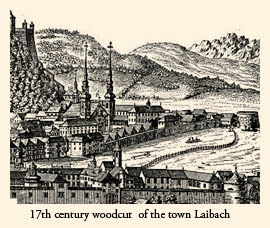 There is no positive data as to the birth place or date of Johannes Manlius (Mandelz, Mannel). The few sources suggest that he was of Crainian or Istrian origins. Similarly, it cannot be decided whether the printer Johannes Manlius is identical with the Melanchthon-student of the same name, who finished his studies in Wittenberg. The printer Manlius was mostly working at various places in West-Hungary.
There is no positive data as to the birth place or date of Johannes Manlius (Mandelz, Mannel). The few sources suggest that he was of Crainian or Istrian origins. Similarly, it cannot be decided whether the printer Johannes Manlius is identical with the Melanchthon-student of the same name, who finished his studies in Wittenberg. The printer Manlius was mostly working at various places in West-Hungary.
The first imprint bearing the name of Johannes Manlius is from Laibach (Ljubljana, SLO), capital of the Province Craina, from 1575. The press of Manlius was supported by the town of Laibach and by protestant nobles of Slavonian national endeavours. 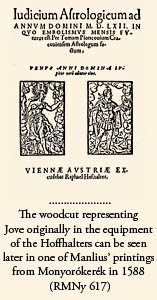 His press was issuing Lutheran Bible-translation in Slovenian language, in Latin script, and he was also dealing with bookselling, and binding. However even his patrons could not help him when his office spreading Lutheranism was suppressed, and in spring 1582 had to leave Laibach.
His press was issuing Lutheran Bible-translation in Slovenian language, in Latin script, and he was also dealing with bookselling, and binding. However even his patrons could not help him when his office spreading Lutheranism was suppressed, and in spring 1582 had to leave Laibach.
There are certain book ornaments and printing types that prove that Manlius, printing since 1575, must have been in connection with the printer Rudolf Hoffhalter. This was at the time when Hoffhalter (having a well-established office formerly in Vienna) stayed at Alsólendva (Lendava, SLO) the estate of Bánffy and Nedelic (Nedelišće, CR) at the estate of György Zrínyi and Boldizsár Batthyány. Later these two magnates played a decisive part in the career of Manlius, a s probably this personal contact has influenced the printer when settling for the rest of his life in West-Hungary under the patronship of Boldizsár Batthyány. István Beythe one of the leading personalities of West-Hungarian Lutherans had probably also some part in inviting Manlius to Németújvár as a printer.

NÉMETÚJVÁR (GÜSSING, A)
(1582-1585, 1595-1597)
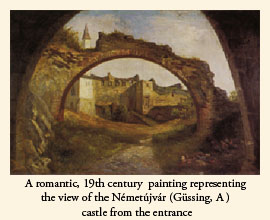 Németújvár ( Güssing, A) was first mentioned in the form Kiscen in one of the record issued by the Hungarian king Géza II. in 1157, in which the king gave permission to Count Walfer to build a monastery there for the Benedictine order. It was the Hungarian king Béla III who built a stone fortress on the site of the monastery. From that time on the settlement was mentioned as "novum castrum" (new castle).
Németújvár ( Güssing, A) was first mentioned in the form Kiscen in one of the record issued by the Hungarian king Géza II. in 1157, in which the king gave permission to Count Walfer to build a monastery there for the Benedictine order. It was the Hungarian king Béla III who built a stone fortress on the site of the monastery. From that time on the settlement was mentioned as "novum castrum" (new castle). 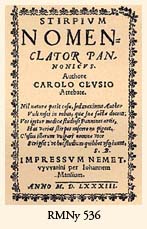 King Lajos II donated the castle to Ferenc Batthyány and it continued to be in the possession of the Batthyány family playing a significant part in the struggls against conquering Osmanic Turks. It was Boldizsár Batthyány visiting West-European universities and keeping contact with Vienna humanists, a bookcollector and patron of both arts and Hungarian proterstants who supported the settling of the printer Manlius in his estate. The printing shop issued during ist first three years 17 books in Németújvár: of these five Hungarian the others German and Latin works. The first book he printed was
King Lajos II donated the castle to Ferenc Batthyány and it continued to be in the possession of the Batthyány family playing a significant part in the struggls against conquering Osmanic Turks. It was Boldizsár Batthyány visiting West-European universities and keeping contact with Vienna humanists, a bookcollector and patron of both arts and Hungarian proterstants who supported the settling of the printer Manlius in his estate. The printing shop issued during ist first three years 17 books in Németújvár: of these five Hungarian the others German and Latin works. The first book he printed was 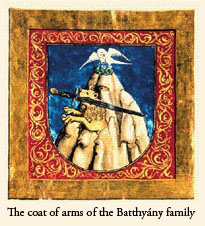 The short summing up of Christian science (Köröztyéni tudománnak rövid summája, RMNy 516) by Istvár Beythe. It was also his printing shop that produced the Latin-Hungarian botanical vocabulary of Carolus Clusius (RMNy 536) living at the time in the court of Batthyány. In his foreword he expressed his gratutude to Beythe from whom during their excursions he had learned the Hungarian names of the plants. Another outstanding book issued by Manlius was the first medical book in Hungarian language a Useful book (Hasznos és felette szükséges könyv, RMNy 532) by Gergely Frankovith the physician of the West-Hungarian free royal town Sopron. This book is also remarkable for the first copper-plate illustrations to be found in book printed in Hungary. At the time of the calendar reform Manlius published an Old and New Calendar for 1583 (RMNy 518A).
The short summing up of Christian science (Köröztyéni tudománnak rövid summája, RMNy 516) by Istvár Beythe. It was also his printing shop that produced the Latin-Hungarian botanical vocabulary of Carolus Clusius (RMNy 536) living at the time in the court of Batthyány. In his foreword he expressed his gratutude to Beythe from whom during their excursions he had learned the Hungarian names of the plants. Another outstanding book issued by Manlius was the first medical book in Hungarian language a Useful book (Hasznos és felette szükséges könyv, RMNy 532) by Gergely Frankovith the physician of the West-Hungarian free royal town Sopron. This book is also remarkable for the first copper-plate illustrations to be found in book printed in Hungary. At the time of the calendar reform Manlius published an Old and New Calendar for 1583 (RMNy 518A).
 |
The same initials as those of Raphael Hoffhalter were later used by Manlius in Laibach between 1575-1578 |

VARASD
(1586-1587)
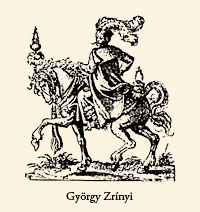 At the interval of two years, in 1586-1587 Manlius was staying in Varasd, the centre of protestantism. It is not known why he left Németújvár and Hungary for Varasd (Varaždin, CRO). After the printer Rudolf Hoffhalter left the nearby Nedelic, the protestants lead by the notar Ivanuš Pergošić had no printing shop at their disposal. It can be assumed that Croatian protestantism was supported by the magnate György Zrínyi and Manlius' office had many commissions there. During his stay he printed the Latin and Croatian works by local authors like Anton Vramec (Postilla veszda znovich zpravlena) and Ivanuš Pergošić (Praefaciones et Epistolae... (RMK II 198). It is especially interesting from book historical point of view, that it must have been here in Varasd that certain book ornaments and printing types of the Hoffhalter press were in some way transferred to Manlius and remained in his possession, following him to the next places of his printing activity. It should be noted, however, that the same book ornaments and types belonged to the common treasure of other, Vienna printers as well, not only to Hoffhalter's equipment. In 1587 Manlius returned to Hungary and settled this time under the patronship of the same György Zrínyi at his West-Hungarian estate Monyorókerék – where he continued to work until 1592.
At the interval of two years, in 1586-1587 Manlius was staying in Varasd, the centre of protestantism. It is not known why he left Németújvár and Hungary for Varasd (Varaždin, CRO). After the printer Rudolf Hoffhalter left the nearby Nedelic, the protestants lead by the notar Ivanuš Pergošić had no printing shop at their disposal. It can be assumed that Croatian protestantism was supported by the magnate György Zrínyi and Manlius' office had many commissions there. During his stay he printed the Latin and Croatian works by local authors like Anton Vramec (Postilla veszda znovich zpravlena) and Ivanuš Pergošić (Praefaciones et Epistolae... (RMK II 198). It is especially interesting from book historical point of view, that it must have been here in Varasd that certain book ornaments and printing types of the Hoffhalter press were in some way transferred to Manlius and remained in his possession, following him to the next places of his printing activity. It should be noted, however, that the same book ornaments and types belonged to the common treasure of other, Vienna printers as well, not only to Hoffhalter's equipment. In 1587 Manlius returned to Hungary and settled this time under the patronship of the same György Zrínyi at his West-Hungarian estate Monyorókerék – where he continued to work until 1592.

MONYORÓKERÉK (EBERAU, A)
(1587-1592)
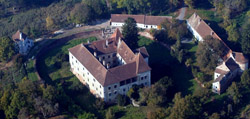 Monyorókerék (Eberau, A) was a fortified water castle built by the Ellerbach family in the 14th century. Its next owner was Tamás Bakócz followed by the magnate family Erdődy and it was from them, through a change of estates, that it came into the possession of the Zrínyi family in 1557.
Monyorókerék (Eberau, A) was a fortified water castle built by the Ellerbach family in the 14th century. Its next owner was Tamás Bakócz followed by the magnate family Erdődy and it was from them, through a change of estates, that it came into the possession of the Zrínyi family in 1557.
In autumn 1587 Manlius printed the German-language record about the siege of Christian troops over the Turkish basa of Szigetwár by Erhard Pöckhl secretary of Zrínyi (RMNy 599). Manlius re-published the medical book of Frankovith illustrated with copper-plates (RMNy 617) as well as a protestant song book by István Beythe without notes (RMNy 648). During these years he was mostly re-printing his former publications, – the cause may have been the increasing religious and personal polemies. In 1592 he moved with his printing shop to Németlövő in County Vas.

NÉMETLÖVŐ (DEUTSCH-SCHÜTZEN, A)
1592-1593
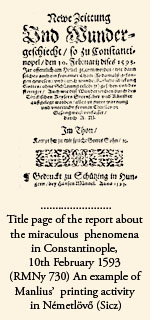 Németlövő (its contemporary Hungarian name was Sicz, today Deutsch-Schützen, A) was a settlement at the Western border of Hungary. Here Manlius was mostly printing popular works and continued to reprint publications of other offices.
Németlövő (its contemporary Hungarian name was Sicz, today Deutsch-Schützen, A) was a settlement at the Western border of Hungary. Here Manlius was mostly printing popular works and continued to reprint publications of other offices.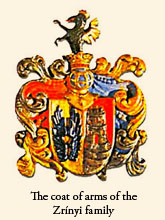 The reason was perhaps the confrontation between Lutherans and Calvinists. Among the religious works printed by him in 1593 there appears a book definitely pointing to the Calvinist direction (RMNy 731). This change may be explained by the Calvinist sympathies of his patron György Zrínyi. No publication of Manlius is known from 1594, therefore it cannot be decided when he left György Zrínyi and returned to Németújvár, to the estate of Ferenc Batthyány, son of his previous patron Boldizsár. The fact remains, that between 1595 and 1597 he continued to issue his printings from Németújvár. A remarkable book of this period was the Herbarium by András Beythe, son of István Beythe (RMNy 766). Soon he turned his attention to the nearby (Sopron)Keresztúr and Sárvár and moved to the estates of the Nádasdy-family.
The reason was perhaps the confrontation between Lutherans and Calvinists. Among the religious works printed by him in 1593 there appears a book definitely pointing to the Calvinist direction (RMNy 731). This change may be explained by the Calvinist sympathies of his patron György Zrínyi. No publication of Manlius is known from 1594, therefore it cannot be decided when he left György Zrínyi and returned to Németújvár, to the estate of Ferenc Batthyány, son of his previous patron Boldizsár. The fact remains, that between 1595 and 1597 he continued to issue his printings from Németújvár. A remarkable book of this period was the Herbarium by András Beythe, son of István Beythe (RMNy 766). Soon he turned his attention to the nearby (Sopron)Keresztúr and Sárvár and moved to the estates of the Nádasdy-family.


KERESZTÚR (DEUTSCHKREUZ, A) – SÁRVÁR
1598-1605
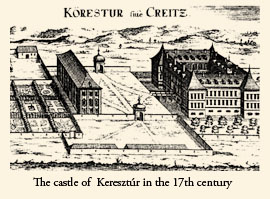 In (Sopron)Keresztúr (ist former Hungarian name was Németkeresztúr, today Deutschkreuz, A) the fortification built by the Kanizsai family in the 15th century was re-built by the Nádasdy family between 1560 and 1615. At the very end of the century, between 1598 and 1605 Johannes Manlius was continuing his printing activity on the estates of the Lutheran magnate Ferenc Nádasdy in Keresztúr respectively Sárvár. He was frequently moving between these two estates: he was working at Keresztúr in 1598-1599, where he returned for a short time directly preceding his death (1605) – while his printing shop was at the intervals in Sárvár (in 1600 and 1602). The outstanding book of this period is the summary of Lutheran confession in Hungarian language, called also the „book of unity” printed by him at Keresztúr in 1598 ( Summája az articulusoknak, RMNy 834).
In (Sopron)Keresztúr (ist former Hungarian name was Németkeresztúr, today Deutschkreuz, A) the fortification built by the Kanizsai family in the 15th century was re-built by the Nádasdy family between 1560 and 1615. At the very end of the century, between 1598 and 1605 Johannes Manlius was continuing his printing activity on the estates of the Lutheran magnate Ferenc Nádasdy in Keresztúr respectively Sárvár. He was frequently moving between these two estates: he was working at Keresztúr in 1598-1599, where he returned for a short time directly preceding his death (1605) – while his printing shop was at the intervals in Sárvár (in 1600 and 1602). The outstanding book of this period is the summary of Lutheran confession in Hungarian language, called also the „book of unity” printed by him at Keresztúr in 1598 ( Summája az articulusoknak, RMNy 834).
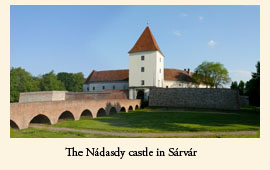
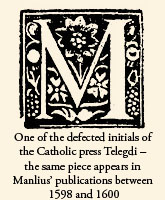 From 1598 on there are certain damaged decorative initians appearing in the printings by Manlius which were previously in the printing equipment of the Telegdi (or Chapter) press of the Catholics in Nagyszombat (Trnava, SK). Further research is needed to find the explanation to this phenomenon: how a part of the Catholic press could find ist way to the printing equipment of the Lutheran Manliu – at a time when the Catholic press of Nagyszombat was still working.
From 1598 on there are certain damaged decorative initians appearing in the printings by Manlius which were previously in the printing equipment of the Telegdi (or Chapter) press of the Catholics in Nagyszombat (Trnava, SK). Further research is needed to find the explanation to this phenomenon: how a part of the Catholic press could find ist way to the printing equipment of the Lutheran Manliu – at a time when the Catholic press of Nagyszombat was still working.

During the nearly 20 years of his printing activity – apart from the interval at Varasd – was serving West-Hungarian protestants. At the same time he is a significant personality of Slovenian and Croatian book-history, as he was also issuing works for them in their native language as well. Although he was changing his place of printing many times, the basic equipment of his press has hardly changed, almost the same printing types and ornaments can be followed through the twenty years. A certain increse can be found in two instances: when wood-cut book illustrations used formerly by Rudolf Hoffhalter, appeared and later when some initials, seemingly identical with those of the Catholic press in Nagyszombat, appeared. Manlius died in 1605 when his office was taken over by Imre Farkas.


- Printing Types - Printer's Flowers - Illustration - Initials - back to the top -


PRINTING TYPES


- Printing Types - Printer's Flowers - Illustration - Initials - back to the top -


PRINTER'S FLOWERS


- Printing Types - Printer's Flowers - Illustration - Initials - back to the top -


ILLUSTRATION


- Printing Types - Printer's Flowers - Illustration - Initials - back to the top -


INITIALS


- Printing Types - Printer's Flowers - Illustration - Initials - back to the top -

LITERATURE:
BORSA Gedeon: Johannes Manlius, a nyomdász és könyvkereskedő a délszlávok szolgálatában. In. Könyvtörténeti írások. I. Bp. 1996. 346-349.
V. ECSEDY Judit: A könyvnyomtatás Magyarországon a kézisajtó korában. 1999. 70-73. V. ECSEDY Judit: A régi magyarországi nyomdák betűi és díszei 1473-1600. A Manlius nyomda. 2004. 117-122., 573-607.
ZSIGMONDY Árpádné: Johannes Manlius és nyomdakészlete (1575-1605) In. OSzK Évkönyve 1982-1983. 297-410.